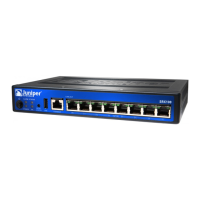Page 3
Default Setup - Allows you to quickly set up the services gateway in the default
configuration. In this mode, you can configure basic system settings, such as the
administrator password, and download purchased licenses. Any additional
configuration can be carried out after completing the wizard setup. If you choose this
mode, proceed to Task 6.
Task 6: Configure the Basic Settings in Default Setup Mode (Method 1)
You can configure the basic settings, such as device name and root password, for your
services gateway.
Before you begin the coonfiguration process, obtain a dynamic IP address on your
services gateway. Use the port labeled 0/0 (interface fe-0/0/0) to connect to your Internet
service provider (ISP). Your ISP will assign an IP address using the DHCP process.
NOTE: It is mandatory to configure only the device name and root password. You can
skip all the other steps by clicking Next to go directly to the Confirm & Apply page to
apply the configuration (Task 8).
1. From the Welcome page, click Default Setup. A warning message appears.
2. Click Yes to accept the default configuration mode.
3. From the Device Information page of the wizard, type the following information:
Device name of the services gateway; for example, SRX100.
Enter and confirm the root password.
NOTE: As you type in the password, the password evaluator indicates the
password strength. We recommend that you use a strong password, which
should contain 12 or more characters and include uppercase and lowercase
letters, numbers, and symbols.
To add users, click Add. Enter the username, password, and role. Click Done.
The username appears in the Administrative Accounts list box.
4. Click Next. The Device Time page appears.
5. Configure the system time by using one of the following options:
Time Server - Enter the NTP server name or IP address.
Manual - Enter the date and time.
6. Click Next. The Summary page appears.
7. Click Next. The Licenses page appears.
8. If you have purchased licenses, type your authorization code and click Download to
automatically retrieve the license. The Sign-in to License Management System page
appears.
9. If you have an existing support account, enter your e-mail address and password.
Click Next. The Licenses page appears. Select I Agree to accept the license, and
click Done.
NOTE: If you do not have a support account, you can create a new account:
Enter your e-mail address and select Create New Account. Click Next.
From the Create Account page, enter your account information. Click Next. The
End User License page appears.
Select I AGREE to accept the license, and click Next.
Make a note of the new username and password. Click OK. You can change
the password by logging in to http://juniper.net/support.
After you submit an access authorization request, if your access is approved, you
will receive an e-mail in less than 24 hours. You can download the license only after
your access is approved.
10. Click Download Now to retrieve your licenses. A pop-up window appears displaying
the license information.
11. Review the downloaded licenses. Click OK and then Next.
12. Proceed to Task 8.
Task 7: Configure the Settings in Guided Setup Mode (Method 2)
Before you begin the configuration process, obtain a static IP address on your services
gateway. Use the port labeled 0/0 (interface fe-0/0/0) to connect to your ISP. Your ISP will
have provided a static IP address. You will not receive an IP address using the DHCP
process.
NOTE: It is mandatory to configure only the device name and root password. You can
skip all the other steps by clicking Next to go directly to the Confirm & Apply page to
apply the configuration (Task 8).
1. From the Welcome page, click Guided Setup and click Next. The Experience Level
page appears.
2. Select one of the following icons that best identifies your experience level, and click
Next:
Basic
Expert
The following table compares the Basic and Expert levels:.
3. Configure the basic options:
a. Enter the device name and root password on the Device Information page. Click
Next. The Device Time page appears.
NOTE: As you type in the password, the password evaluator indicates the
password strength. We recommend that you use a strong password, which
should contain 12 or more characters and include uppercase and lowercase
letters, numbers, and symbols.
b. Configure the system time by using one of the following options:
Time Server - Enter the NTP server name or IP address.
Manual - Enter the date and time.
c. Click Next. The Summary page appears displaying the basic device information
configured.
d. Click Next. The Security Topology Overview page appears.
Basic Expert
Can configure only three internal zones Can configure more than three internal
zones
Can configure static and dynamic IP for the Internet
zone
Can configure static IP, static pool, and
dynamic IP for the Internet zone
Cannot configure internal zone service Can configure internal zone service
Cannot configure internal destination NAT Can configure internal destination NAT

